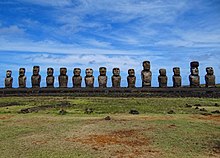Rapa Nui mythology

Rapa Nui mythology, also known as Pascuense mythology or Easter Island mythology, refers to the
.Origin myth
According to Rapa Nui mythology
Hiva Nuku Hiva, Hiva Oa, Fatu Hiva, Mount Oave, Marquesas Islands, Tahiti, Fenua. They landed at Anakena beach and his people spread out across the island, sub-divided it between clans claiming descent from his sons, and lived for more than a thousand years in their isolated island home at the southeastern tip of the Polynesian Triangle until the arrival of Dutch captain Jacob Roggeveen, who arrived at the island in 1722.[2]
Ancestor cult
The most visible element in the culture was the production of massive statues called
symbiotic relationship with the dead where the dead provided everything that the living needed (health, fertility of land and animals, fortune, etc.), and the living through offerings provided the dead with a better place in the spirit world. Most settlements were located on the coast and moai were erected along the coastline, watching over their descendants in the settlements before them, with their backs toward the spirit world in the sea.[3]
Tangata manu cult
The
Catholicism, though the birdman's popularity and memory were not erased and it is still present in the decoration of the island's church.[5]
Deities and heroes
- Make-make, creator of humanity
- Uoke, tectonic deity
- Hotu Matu'a, legendary king and cultural hero
- Aku-Aku, spirits of the dead
- Manana Take
- Tangata manu
- Hanau epe
- Haua
- Hina-Oio
References
- ^ Carlos Mordo, Easter Island (Willowdale, Ontario: Firefly Books Ltd., 2002)
- ISBN 978-1-59884-077-3. Retrieved 10 January 2012.
- ISBN 978-0-8160-7109-8. Retrieved 10 January 2012.
- ISBN 978-1-57324-864-8. Retrieved 12 January 2012.
- ISBN 978-1-59884-077-3. Retrieved 10 January 2012.
Further reading
- Kjellgren, Eric; et al. (2001). Splendid isolation: art of Easter Island. New York: The Metropolitan Museum of Art. ISBN 9781588390110.
- Robert D. Craig. Dictionary of Polynesian mythology. Greenwood Publishing Group, 1989 ISBN 978-0-313-25890-9
- Peggy Mann. Easter Island: land of mysteries. Holt, Rinehart, and Winston, 1976. ISBN 978-0-03-014056-3
External links
- Easter Island legends and myths - Easter Island Traveling

